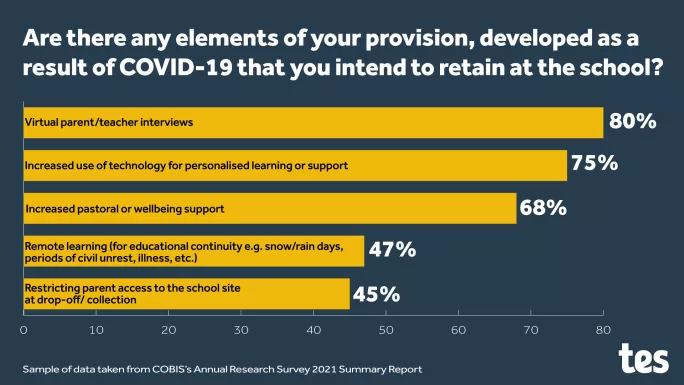- Home
- Analysis
- Specialist Sector
- How the pandemic is reshaping international education
How the pandemic is reshaping international education

Virtual parent meetings, remote recruitment strategies and greater use of technology to boost learning are just some of the ways of working that international schools expect to remain after the pandemic, according to a report by the Council of British International Schools (COBIS) seen exclusively by Tes.
Specifically, 80 per cent of British international schools intend to keep virtual parent-teacher meetings after the pandemic, and 75 per cent will maintain an increased use of technology for personalised learning or support.
A further 68 per cent of schools say they will continue their increased focus on wellbeing and pastoral support, while 47 per cent say they will continue to use remote learning for educational continuity during events such as extreme weather or civil unrest.
The findings come from COBIS’s Annual Research Survey 2021 Summary Report, based on data collated from a survey of 115 British international schools across the globe during October and November 2021, carried out in partnership with GL Education.

A catalyst for change
Colin Bell, CEO of COBIS, says the insights into these new ways of working that international schools intend to keep underline what “a catalyst for change” the pandemic has been.
“It’s been a tremendous learning curve in terms of CPD and proving the value of investing in edtech,” he tells Tes.
“It shows schools can always find ways to improve the learning opportunities for children and in the future, it should mean that educational disruption - such as from extreme weather - is far less common and that wherever a pupil is in the world should be no barrier to learning.”
Rob Ford, director of Heritage International School in Chisinau, Moldova, says the stats around virtual parent meetings, in particular, are no surprise, noting that his school “definitely” intends to retain the option of virtual meetings ”beyond Covid”.
“The very nature of the diverse and demanding careers of the parents who send their children to our schools means they are often not in the country, or working hours and schedules that make it convenient to drive through the terrible rush-hour traffic across Chisinau just to get to a one hour PTA.”
More international news and analysis
- iQTS: Could iQTS solve the UK’s teacher supply shortage?
- New job?: How to decide if it’s time to move jobs - or stick around
- Recruitment: Long read: Will the rise in local hires continue?
However, he says this does not mean the end of face-to-face meetings, but instead believes it will help complement the time when a physical meeting is required.
“It enhances and works alongside using a physical meeting for a deeper individual dialogue, if and when needed. It’s another good tool in the way we can communicate effectively with home and in an international school with lots of different nationalities and more fluid, transitory global students and families, anything that can develop a better relationship and understanding is to be welcomed.”
Iain Sallis, campus principal of Tenby Schools Setia Eco Park in Malaysia, concurs that it is the flexibility that virtual meetings offer that is key to their future use.
“We will not use virtual meetings all the time but they will become a feature of everyday life,” he says, noting that it may be the case that schools can simply offer parents a choice of an online or in-person meeting to suit their needs.
Financial shocks subside
Meanwhile, the report also found some of the initial shocks of the pandemic in 2020 appear to have eased, with 51 per cent of schools reporting an increase in applications for students (from just 21 per cent in 2020) and fewer schools now offering instalment payment plans to parents (69 per cent, compared with 90 per cent), suggesting there is more certainty around fees being paid on time.
However, there are still issues, with many schools reporting that core areas of investment have had to be cut back - 31 per cent had to reduce spending on CPD over the last 12 months, 33 per cent have postponed or cancelled new facilities or upgrades to existing facilities, and 21 per cent have reduced staff levels.
Bell says this shows that despite the pandemic easing, it is not over - and that schools were having to make some tough decisions.
“It’s clear schools and parents have experienced financial distress in the pandemic - a lot of it beyond their control, such as with exchange rates or fluctuating prices - and that has forced many schools to really look hard at where they are spending their money.”

Recruitment challenges
Furthermore, recruitment continues to pose challenges, with 42 per cent of schools reporting delays or difficulties with visas and pre-employment checks, and 34 per cent reporting delayed start of international staff owing to travel restrictions.
This has also led to changes in recruitment practices, with 35 per cent now saying they intend to keep remote recruitment, such as video interviews with prospective candidates.
Matt Payne, head of lower school at Nord Anglia International School New York, says this is something he sees as a major silver lining of the pandemic.
“Being international, we often have applicants that are outside of the country [and] Zoom has made it so much easier to conduct interviews and meetings,” he tells Tes.
“This is something that was often done before for international applicants, though it was often through Skype. Zoom has made things a lot smoother so I can see interviews continuing like this in the future.”
For some though, like Sallis in Malaysia, it simply represents a continuation of a trend that had started before the pandemic: “I think mid-range market schools like ours have always done this anyway due to cost, so for us, it’s normal practice and will remain online.”
Another way that international schools appear to be tackling these recruitment issues is by hiring more international teachers already in the sector - something that 33 per cent of schools said they are doing - and hiring more local teachers, something 23 per cent of schools said they had done.
Commentating on this, Bell says: “The recruitment of more local teachers is something that we have seen growing, and the report underlines what we have heard anecdotally about this - it has the benefit of boosting diversity in international schools and it also ties in with the iQTS strategy from the government.”
Onward journeys
A final interesting insight from the data is that the UK as a university destination after final exams has seemingly lost some of its allure, with 42 per cent of the 2,459 leavers across all responding schools choosing the UK - down from 50 per cent in 2020 and 53 per cent in 2019.
Reasons for this decline are wide-ranging: half cited the cost of living in the UK, while 36 per cent said they are worried about securing the right visa.
Linked to this perhaps is the fact that 30 per cent cited Brexit as a reason not to move to the UK, while 11 per cent said the “perceived welcome for international students by the UK” was a cause of concern.
Liz Free, the director of International School Rheintal in Switzerland, says this is a trend she has seen play out clearly in her school.
“Last year we saw a significant shift in the bias of student choice for university by country,” she explains. “Historically, we would normally have about 20-25 per cent of students heading to the UK. However, in 2021, we saw 8 per cent going to the UK.”
She notes that many of the reasons cited are exactly those listed above: “The Brexit effect leading to high university costs, Covid and the political climate in the UK have all, sadly, made a UK university experience less desirable than previous years.”
Given this, Bell says that the government must be aware that a changing mindset among international students could impact its ability to hit overseas student recruitment targets.
“If the UK government is to meet its target from the 2021 International Education Strategy of increasing the number of international HE students studying in the UK to 600,000 per year,” he says, “it will need to consider what further support and recognition it can offer to high-quality, accredited British schools operating overseas.”
You need a Tes subscription to read this article
Subscribe now to read this article and get other subscriber-only content:
- Unlimited access to all Tes magazine content
- Exclusive subscriber-only stories
- Award-winning email newsletters
Already a subscriber? Log in
You need a subscription to read this article
Subscribe now to read this article and get other subscriber-only content, including:
- Unlimited access to all Tes magazine content
- Exclusive subscriber-only stories
- Award-winning email newsletters



